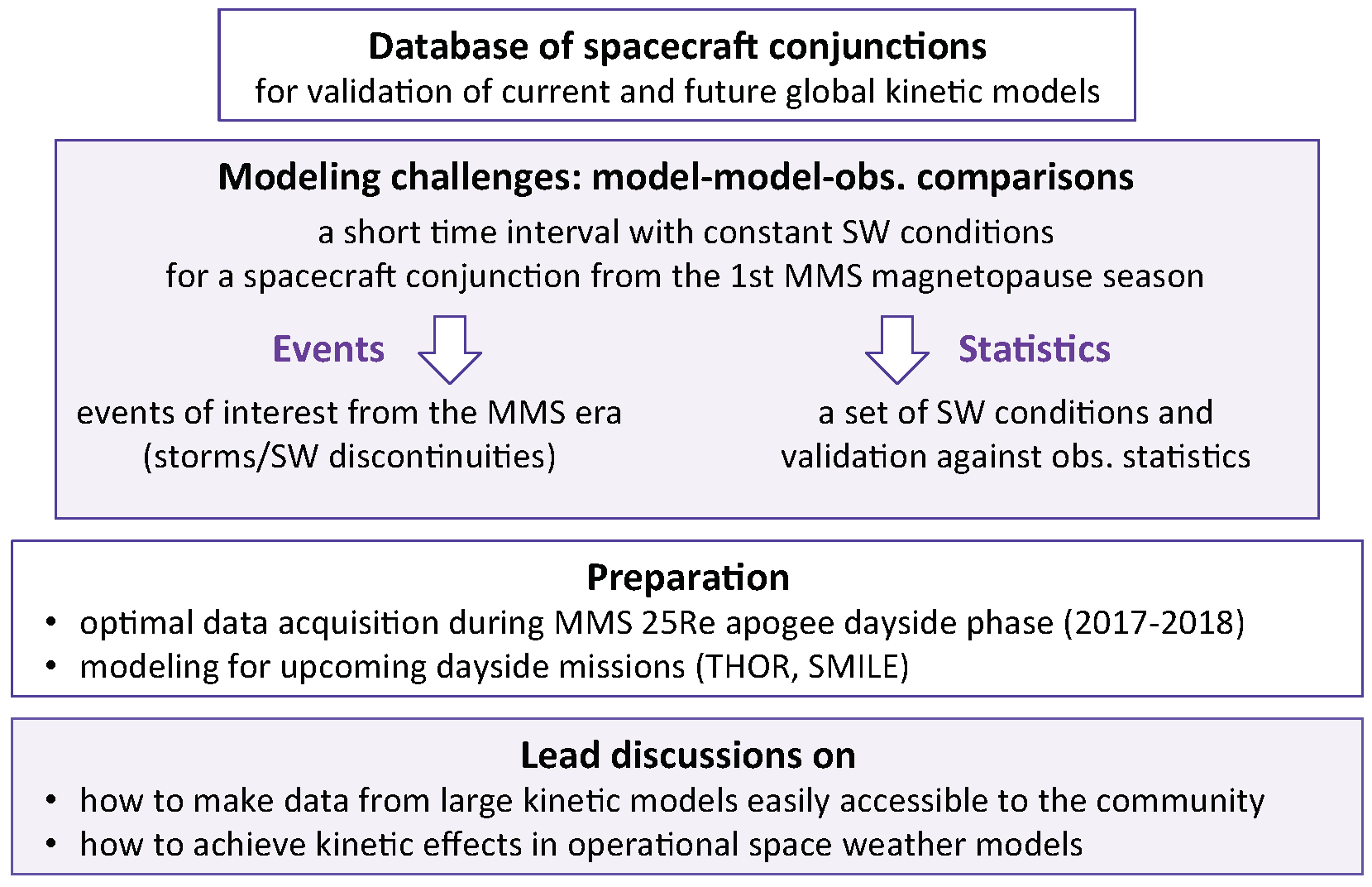FG: Dayside Kinetic Processes in Global Solar Wind-Magnetosphere Interaction
A venue for joint modeling and observational efforts to understand kinetic processes in a global context.
We’re currently using an online form to collect your ideas, opinions, and feedback on future plans and activities for the Focus Group. Please use this link to submit your input, especially if you were unable to attend the Summer Workshop: https://docs.google.com/forms/d/e/1FAIpQLScvvPORcIEAYS6Y19noaucJ5PLtEsbeedRld7oJwPAEE0jCeQ/viewform
Contents
Focus Group Chairs
- Heli Hietala, University of California Los Angeles, (heli[at]igpp.ucla.edu) & University of Turku, Finland
- Xochitl Blanco-Cano, Universidad Nacional Autónoma de México, (xbc[at]geofisica.unam.mx)
- Gabor Toth, University of Michigan, (gtoth[at]umich.edu)
- Andrew P. Dimmock, Swedish Institute of Space Physics, Uppsala, Sweden, (andrew.dimmock[at]irfu.se)
- Ying Zou, University of Alabama in Huntsville, USA, (yz0025[at]uah.edu)
Term: Five years (2016-2020)
Dayside Kinetics Challenge
Details of the dayside kinetics challenge can be found here
Introduction to the focus group
Topic
Kinetic processes on the order of ion and electron scales are inherent and abundant throughout dayside regions such as the foreshock, bow shock, and the magnetosheath. Nonlinear dynamics allow small variations to grow to structures of up to Earth radii in scale, resulting in significant spatial and temporal variations in dayside plasma properties. Impinging on the magnetopause these structures may facilitate/inhibit magnetic reconnection. Localized magnetopause indentations caused, e.g., by impacts of magnetosheath high-speed jets can drive surface waves and/or low frequency compressional waves within the dayside magnetosphere. These waves can excite field-line resonances, which modify the drift paths of radiation belt electrons resulting in belt depletion through magnetopause shadowing. Extreme transients like foreshock bubbles cause drastic global scale disturbances in the whole magnetosphere-ionosphere system.

- For statistical mapping details see: Dimmock & Nykyri, 2013 (DOI:10.1002/jgra.50465) and Dimmock et al, 2015 (DOI:10.1002/2014JA020734)
- Vlasiator is developed by the European Research Council Starting grant Quantifying energy circulation in space plasma (200141-QuESpace) received by the Vlasiator PI. Vlasiator has also received funding from the Academy of Finland. Vlasiator copyright belongs to the Finnish Meteorological Institute. Vlasiator FMI webpage
- The development of MHD-EPIC is supported by the Space Hazards Induced near Earth by Large, Dynamic Storms (SHIELDS) project DE-AC52-06NA25396, funded by the U.S. Department of Energy through the Los Alamos National Laboratory Directed Research and Development program and by the INSPIRE NSF grant PHY-1513379
This focus group aims to be a synergy of both modeling and experimental efforts, to address to what extent dayside kinetic processes regulate the global magnetospheric dynamics. Understanding these cross-scale coupling processes is crucial in the development and validation of models which aim to accurately and reliably characterize and predict the solar wind–magnetosphere coupling.
Goals & Deliverables
Broad goals of the focus group are to contribute to the understanding of (including but not limited to):
- Bow shock and foreshock dynamics: particle acceleration in foreshock transients; effect of foreshock transients on bow shock structure and their transmission downstream
- Magnetosheath: propagation of meso-scale variations such as high speed jets and filamentary density structures; reconnection in turbulence; waves generated by instabilities and FTEs
- Response of magnetopause processes to upstream variations: reconnection, surface waves, and Kelvin-Helmholtz vortices
- Response of the dayside inner-magnetosphere: excitation of waves; radiation belt effects
The deliverables include:
- Database of spacecraft conjunctions under different solar wind conditions providing both the coverage and the suitable observational data products (fields, particle distribution functions) for validation of current and future global kinetic models.
- Modelling challenge: Events Comparison of different models with multi-point observations from MMSera events chosen by the community. The results will put the novel observations into global context.
- Modelling challenge: Statistics Dayside dynamics in 2D and 3D kinetic and MHD models under different upstream conditions (IMF angle, solar wind velocity) and season (dipole tilt). The results will be compared with observational statistics. This challenge will reveal how similar/different the results are for the different approximations, and point ways to improve future models.
Expected Activities
During the first years we will have coordinated activities with the Transients FG and the Reconnection FG on linking local, conjugate dayside observations to global dynamics via simulations. In the run-up to the MMS extended-configuration dayside season we will discuss optimal data acquisition strategies, informed by numerical models, joint with HSO activities. In 2018 we will collect the first observations from this phase. The two modeling challenges will run in parallel. The common starting point is a single, short time interval with constant solar wind conditions matching an observed spacecraft conjunction. Towards the end of the FG the Events challenge will proceed to actual storms and solar wind discontinuities. The Statistics challenge has more emphasis on model-model comparisons, and the in situ validation will be against observational statistics, first from THEMIS/Cluster and then from MMS. As a part of the modeling challenges we will agree on a road map to make the data from kinetic models available and accessible to the community. Towards 2020 we will discuss how to achieve kinetic physics in operational space weather models.
You can download the actual proposal here
Workshops
Here you can find summaries of previous workshops and planned session for future ones. Each workshop from summer 2016 is listed below.
- 2020 Virtual Summer Workshop
- 2019 Summer Workshop, Santa Fe, NM
- 2018 Mini GEM, Washington DC
- 2018 Summer Workshop, Santa Fe, NM
- 2017 Summer Workshop, Portsmouth, VA
